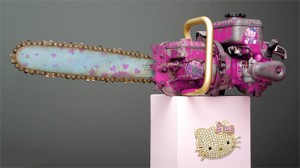Elementary school. I glance around the classroom and notice a cartoon cat’s face on many of my classmate’s stationary, lunchboxes, backpacks etc. I do not pay much attention to it, I think to myself that it is some sort of Japanese cartoon fawned over by young girls and that’s that. Years later, I am in a small town in Croatia and see grown men walking around in shirts with this same cat’s face. There are umbrellas, beach towels, sunscreen, sandals, you name it, all marked with the cat. How can it be that years later and far from home, I am still surrounded by this expressionless cat’s face? Now however, it is not only young girls who tote the cat around on their school supplies, but teenagers, adults, seniors, females, males- everyone everywhere- who seems to be using products that could otherwise stand by themselves, but which appear more valuable because they display this cat’s face. Yes, I am talking about Hello Kitty. I am baffled and confused by Hello Kitty’s takeover of the world. The picture of the cat itself offers no real perk to the consumer, yet any random (yes, I mean very random) product that manages to incorporate Hello Kitty in some way, is suddenly a more sought after item.  Perhaps, as one blog comments (warning: foul language), this is partly because Hello Kitty DOES NOT HAVE A MOUTH and therefore is expressionless. In this way, Hello Kitty is a versatile symbol that can be applicable to any product, as instead of offering an emotion, Hello Kitty serves as a blank canvas for the consumer, resonating with whatever emotion the consumer is feeling at the time, or associates with the product. Indeed, by being a mouth-less character, Hello Kitty relates to the consumer, allowing them to project whatever emotion they wish upon the product they will be purchasing.
Perhaps, as one blog comments (warning: foul language), this is partly because Hello Kitty DOES NOT HAVE A MOUTH and therefore is expressionless. In this way, Hello Kitty is a versatile symbol that can be applicable to any product, as instead of offering an emotion, Hello Kitty serves as a blank canvas for the consumer, resonating with whatever emotion the consumer is feeling at the time, or associates with the product. Indeed, by being a mouth-less character, Hello Kitty relates to the consumer, allowing them to project whatever emotion they wish upon the product they will be purchasing.
Monthly Archives: March 2013
The Illusion of Choice
It is becoming well known that the many brands you see are not necessarily from different companies and in fact, often all belong to one of a few major companies. It is very tricky for us consumers to distinguish which brands belong to what. A merchandising manager could create in-store product displays that seem to offer plenty of choice when in reality, a consumer’s decision to choose one brand over another does not really matter, as both belong to the same company. This blog post by David Griner for Adweek discusses the limited choices offered to consumers and tests our knowledge of the parent companies of some well-known brands with a ‘Brand Paternity Test’. Take the test, the results might surprise you! I suppose the main question here is whether this ‘illusion of choice’ should matter to consumers.  If a consumer still gains value from choosing one brand over another (even if they are really both from the same company) is there a problem? In my opinion, things do get shifty when companies use multiple brands to almost ‘trick’ the consumer into thinking that they have more choices than they really do. Consumers could be trying to make purchasing decisions based on which companies they support, and if they are not given full information on what brands belong to which companies, they could easily make misinformed purchasing decisions. For example, a few years ago, a consumer who did not want to support tobacco use could have easily- and unknowingly- been supporting the makers of cigarettes all along through purchases of any Kraft food product, since both Kraft foods and Marlboro both belonged to one company – the Atria group. Oh, by the way, I scored 9/15 on Adweek’s Brand Paternity Test…how did you do?
If a consumer still gains value from choosing one brand over another (even if they are really both from the same company) is there a problem? In my opinion, things do get shifty when companies use multiple brands to almost ‘trick’ the consumer into thinking that they have more choices than they really do. Consumers could be trying to make purchasing decisions based on which companies they support, and if they are not given full information on what brands belong to which companies, they could easily make misinformed purchasing decisions. For example, a few years ago, a consumer who did not want to support tobacco use could have easily- and unknowingly- been supporting the makers of cigarettes all along through purchases of any Kraft food product, since both Kraft foods and Marlboro both belonged to one company – the Atria group. Oh, by the way, I scored 9/15 on Adweek’s Brand Paternity Test…how did you do?
